Civil Rights / Cold War
Protests Spread
Following Nashville's success, sit-ins spread to Chattanooga, Knoxville, Memphis, and Jackson. In fact, the Nashville students provided the "model” to follow for mass demonstrations that occurred throughout the South.
Memphis
In Memphis, a small group of LeMoyne College and Owen Junior College students organized sit-ins on March 18, 1960. After first targeting the main public library, where 40 students sat at tables, the protests spread to department stores.
More than 300 demonstrators were arrested on charges of loitering. Ten local lawyers, representing the National Association for the Advancement of Colored People (NAACP), were able to get most of the charges dropped.
Protests in Memphis continued throughout the summer of 1960, organized with help from the local NAACP's secretary Maxine Smith. These protests resulted in the integration of buses and the city's parks.
Knoxville
In Knoxville, where there was a relatively small black community, most black leaders urged negotiations with merchants, but were opposed to direct action protest. Students ignored them and began sit-ins on May 12, 1960.
Black ministers R.E. James, W.T. Crutcher, Matthew A. Jones, Eugene Patterson, and Robert Booker answered the call and helped organize Knoxville College students, who successfully integrated downtown lunch counters.
Black ministers R.E. James, W.T. Crutcher, Matthew A. Jones, Eugene Patterson, and Robert Booker answered the call and helped organize Knoxville College students, who successfully integrated downtown lunch counters.
Chattanooga
After hearing about sit-ins in Nashville, Howard High School students held a sit-in at McClellan's in Chattanooga. After the lunch counter closed, protesters sang and prayed together.
Unlike other cities, Chattanooga students acted without support from black leadership, who believed an accommodation strategy was best. When students failed to integrate Warner Park, preachers Horace Tyler and Dogan Williams helped to stage more sit-ins at S. H. Kress, Woolworth's, and W. T. Grant.
Jackson
In Jackson, students at the all black Lane College got involved. In October 1960, six Lane students refused to move to the back of a city bus. They organized a bus boycott that worked so well city officials agreed to end the practice two days later.
The students, supported by the local African American community, started sit-ins at the Woolworth's and McClellan's. A boycott of local merchants during Christmas 1960 followed.
After hearing about sit-ins in Nashville, Howard High School students held a sit-in at McClellan's in Chattanooga. After the lunch counter closed, protesters sang and prayed together.
Unlike other cities, Chattanooga students acted without support from black leadership, who believed an accommodation strategy was best. When students failed to integrate Warner Park, preachers Horace Tyler and Dogan Williams helped to stage more sit-ins at S. H. Kress, Woolworth's, and W. T. Grant.
Jackson
In Jackson, students at the all black Lane College got involved. In October 1960, six Lane students refused to move to the back of a city bus. They organized a bus boycott that worked so well city officials agreed to end the practice two days later.
The students, supported by the local African American community, started sit-ins at the Woolworth's and McClellan's. A boycott of local merchants during Christmas 1960 followed.
Movie Theaters
In Nashville, the students decided to tackle the movie houses. Nashville movie theaters made blacks sit upstairs. They had to buy their tickets downstairs, go outside in the alley, and then climb up the fire escape.
In Nashville, the students decided to tackle the movie houses. Nashville movie theaters made blacks sit upstairs. They had to buy their tickets downstairs, go outside in the alley, and then climb up the fire escape.
So in February, 1961, student protesters would stand in line and ask to buy an downstairs ticket. When they were refused, they would go the back of the line and do it again. This way they tied up the ticket seller. They called it a stand-in.
White toughs started verbally abusing them and hitting them. The police showed up and arrested the protesters, not the people hitting them. John Lewis, James Bevel, and Bernard Lafayette were all arrested. Eventually the movie theater owners gave in and let blacks sit intermingled with whites downstairs.
While widespread, sit-ins and stand-ins could only desegregate a handful of businesses at a time. It was going to take a long time to overcome well-entrenched traditional customs without help from the federal government. The Boynton decision, which banned segregation on interstate transportation, like buses, provided a new opportunity for activists to force change.
Picture Credits:
- Photograph of LeMoyne and Owen college students in Memphis conducting a sit-in. The Nashville sit-in model spread throughout the South. Used with permission of Panopticon Galleries, Ernest Withers Collection. This photograph cannot be reproduced without their permission.
- Photograph of African Americans with clinched fists. The photograph was taken by Marilyn Califf in 1969 at the corner of Beale and Second streets in Memphis during a demonstration held on the first year anniversary of Dr. Martin Luther King Jr.'s death. A copy of this photograph, printed in 2001 for a museum competition, was a "Best of Tennessee" purchase award. Tennessee State Museum Collection, 2001.121.2
- Photograph of students lying-in in Nashville -- another form of non-violent resistance. These protesters are blocking traffic at the intersection of Seventh and Church streets in downtown Nashville. Nashville Banner Archives, Special Collections Division, Nashville Public Library
- Knoxville College students march to downtown lunch counters on March 7, 1960 as the first stage of the Knoxville sit-in movement begins. Photo provided by Beck Cultural Center, Knoxville News Sentinel photograph
- A young Knoxville woman is carried to the police wagon still singing and clapping out her protest. Note that she is being carried by an African American patrolman. The photograph is dated March 1963. Photo provided by Beck Cultural Center, Knoxville News Sentinel photograph
- Two white men show their feelings against the sit-ins taking place in Knoxville in 1960. The sign proclaims that "sit-down demonstrations are un-American." Photo provided by Beck Cultural Center, Knoxville News Sentinel photograph
- More than 100 black and white students were arrested after sitting in and refusing to leave the office of Memphis State University President C.C. Humphreys in the administration building on April 28, 1969. Days earlier members of the Black Student Association had approached Humphreys for money to bring U.S. Rep. Adam Clayton Powell to campus as a speaker. When Humphreys said no, the students returned days later and the sit-in began. Photograph by Barney Sellers, Courtesy of The Commercial Appeal
-
Fireman turned on water hoses to be used against sit-in protesters in Chattanooga in 1960. In this city, many of the protesters were high school students. Courtesy of the Chattanooga History Center
-
A woman blocks the way as African Americans attempt to sit-in at a lunch counter at a Memphis department store in 1961. Copyright by Bettman/CORBIS. May not be reproduced without permission of CORBIS
-
African Americans hold a "stand-in" at downtown Nashville movie theaters in February 1961. The movie being shown was the Misfits. The state capitol is in the background. The protesters would ask to buy a ticket on the main floor instead of the segregated balcony. When refused, they would go to the end of the line to ask again. Copyright by Bettman/CORBIS. May not be reproduced without permission of CORBIS
Civil Rights / Cold War >> Civil Rights Movement >> Nashville Sit-Ins >> Protests Spread
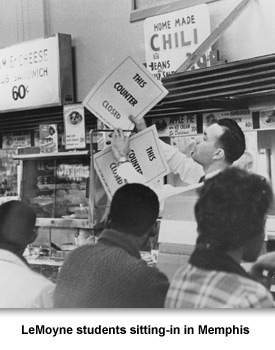
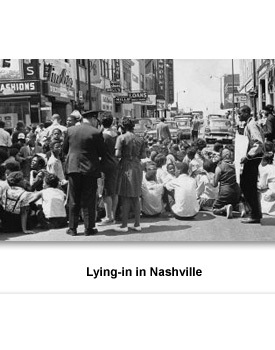
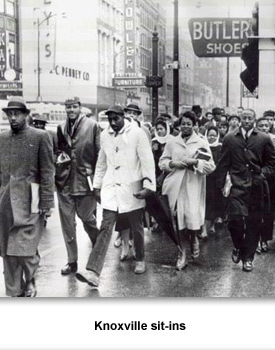
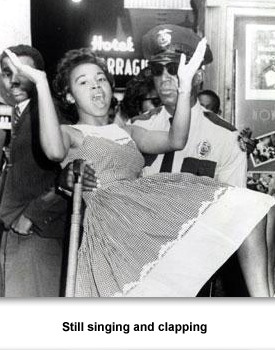

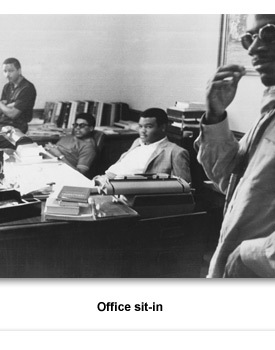
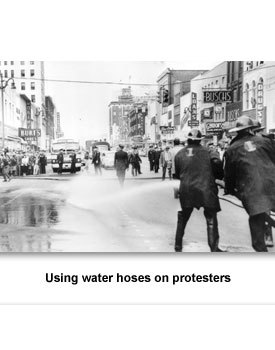
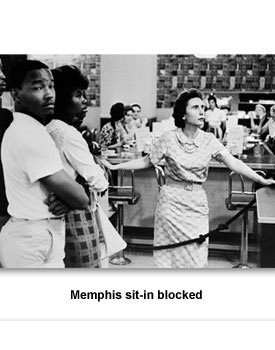
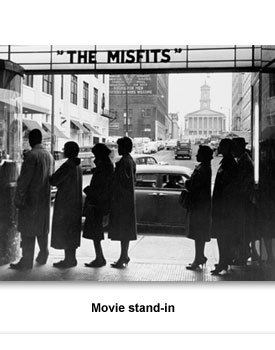
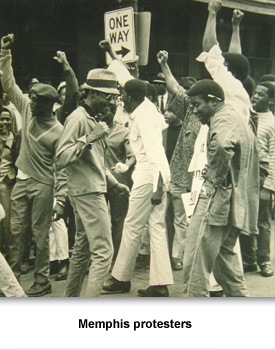
 Sponsored by: National Endowment for the Humanities
Sponsored by: National Endowment for the Humanities